Rolling out OKRs at your organization or planning to scale up your OKR game. Investing in the best OKR software is the next big step to achieve OKR success.
Are you looking to boost your company’s productivity and achieve your goals in a more streamlined and efficient manner?
To stay on track and achieve goals, businesses need to have a comprehensive performance management system in place, and OKR is one such popular method to achieve this. OKRs help organizations align their team’s efforts with business goals, prioritize tasks, and monitor progress.
One of the best ways to achieve OKR success is by implementing an effective OKR tool.
In the fast-paced and competitive business environment, organizations have to stay focused and aligned to drive performance and success. With the right OKR software, teams can set, track, and measure progress towards their objectives and key results easily, and collaborate more effectively to drive engagement, accountability, and results.
There are plenty of OKR tools available in the market, each with its unique features and benefits. With so many options to choose from, it can be challenging to decide which tool is best suited for your organization.
In this blog post, we’ll take a look at the 10 best OKR tools that you should consider in 2024 to help your organization succeed.
What is OKR Software?
OKR software is a digital solution designed to streamline the OKR goal-setting process. Providing a centralized platform for setting, tracking, and measuring progress towards Objectives and Key Results, enables organizations to drive performance, align teams, and optimize outcomes.
So, let’s explore the 10 best OKR software solutions in the market and discover how they can help your organization optimize its performance and achieve its goals.
Why you need an OKR software?
OKRs methodology, made famous by Google, has been proved to bring meteoric success to many famous organizations including Intel, Netflix, and Spotify.
“A successful system needs only to answer two questions: Where do I want to go? How will I pace myself to see if I’m getting there? Objectives and Key Results answer these questions.” – Andy Grove, Intel CEO
Although most organizations start implementing OKRs using spreadsheets. As your organization scales up, managing OKRs and keeping track manually becomes impossible. Read our blog on why you need OKR software instead of spreadsheets to understand the hiccups you will face if you use spreadsheets.
OKR software provides you a central location for documenting your OKRs and helping you-
- To get clarity and find the right direction while setting OKRs.
- To connect OKRs at each level of the organization and align your priorities.
- To get better support in performance management.
- To make tracking progress more effective, easy, and error-free.
- To measure OKR performance across all organizational levels.
- To increase transparency and communication on all OKR matters.
- To foster a greater sense of accountability.
- To make your OKR framework more agile.
OKR Software – Rated 4.8 on G2
Empower your managers to be a better leader with essential performance tools & personalized coaching support.
10 Best OKR Tools to Checkout in 2024
1. Peoplebox

Peoplebox is a highly-rated, holistic platform that helps enterprises align their goals and drive performance. With its easy-to-use platform and focus on coaching and feedback, this OKR solution enables teams to set and track their objectives and key results, collaborate effectively and achieve success.
Notable features of Peoplebox
1. Run performance reviews in Slack
This feature helps you run an entire review cycle in Slack and removes the need for another tool. It integrates OKRs and KPIs with performance reviews and gives real-time updates on the progress. It provides a 360-degree view of the entire review cycle and lets you manage nudges, auto-reminders, etc. in a single place.
2. Single-page view
Peoplebox is a recipient of #1 easy-to-use platform award by G2. This is attributed to the single-page view of the tool, where you find all company goals, tasks, progress reports, charts, performance tracking, etc. It is extremely easy to navigate through the app, which makes setting up the software, setting goals and monitoring progress easier.
3. Customizable dashboards for business reviews
With Peoplebox, you can customize your dashboard and include KPIs, narrations, charts, and action items for automatically tracking progress towards your OKRs. This feature helps you identify potential roadblocks in advance, allowing your team to focus on solutions during weekly and monthly business review meetings, resulting in more effective meetings.
4. Integration with 100+ native tools
By integrating with various tools such as Slack, Jira, Asana, MySQL, Google Sheets, Salesforce and others, Peoplebox enables automatic real-time goal updates. It also allows you to create custom dashboards for your business reviews and weekly check-ins, which are auto-populated with the latest information from these integrated tools.

5. KPI Board
Peoplebox allows you to incorporate OKRs and KPIs into your business review meetings to streamline the review process and free up more time to address roadblocks. It also enables you to enhance your team’s ability to execute on strategic goals and achieve better outcomes.
Pros of Peoplebox
- Peoplebox is an all-in-one solution that includes OKRs and features like business review meetings, KPIs tracking, complete performance management, and employee engagement. It integrates 100+ native tools and allows you to perform reviews on Slack, reducing the need of several tools.
- Peoplebox offers a powerful one-on-one meeting management tool that helps managers and team members to have more productive, regular meetings. The one-on-one meeting feature facilitates regular check-ins with team members, provides an agenda, and allows you to take notes and track action items for follow-ups. This promotes effective communication and collaboration within the team.

- It has an intuitive user interface which is extremely easy to use and has OKR at the center of everything, which enables faster delivery of strategy execution and driving outcomes.

- Peoplebox enables you to set and track individual, team, and company KPIs across timeframes, including weekly, monthly, quarterly, or yearly views.
- Peoplebox offers increased automation capabilities, including automated tracking of OKRs, follow-ups and reminders, and auto-generation of business review reports, etc.
- Peoplebox offers on-demand OKR coaching to help businesses set moonshot objectives and key results that align with their overall business strategies, and to promote widespread adoption of OKRs across all teams.
Cons of Peoplebox
- The software’s detailed insights, presented in percentage form, can feel overwhelming to struggling businesses because of how accurately and clearly it presents the business growth.
- It doesn’t provide the option of anonymous feedback which creates complete transparency.
2. Leapsome
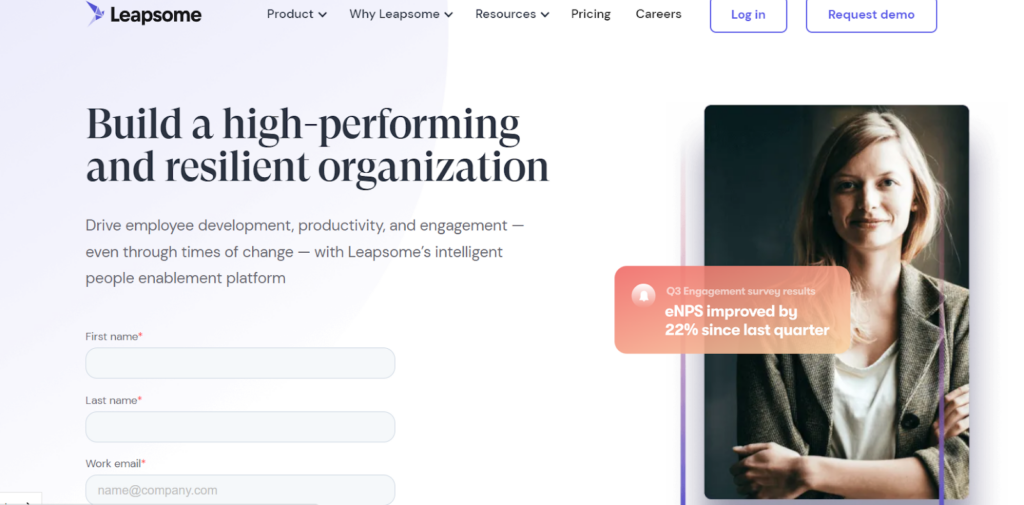
Leapsome is another popular OKR tool that enables organizations to set, track, and achieve their goals. The software offers a range of features and functionalities, including customizable dashboards, integrations with various tools, real-time progress tracking, and employee engagement tools.
Notable features of Leapsome
1. Customizable OKR Frameworks
Leapsome allows businesses to set up customized OKR frameworks that fit their specific needs and goals. With Leapsome, you can create and track your objectives, key results, and progress updates on a flexible and personalized dashboard.
2. Goal tree
Leapsome allows connecting company, team and individual goals to generate a goal tree highlighting ownership and dependencies of OKRs.
3. Collaborating on goals
With Leapsome, you can share and request feedback on goals, leave comments and discuss progress
Pros of Leapsome
- Leapsome is highly customizable, allowing businesses to tailor the platform to their specific needs and goals. The software offers a range of modules and features that can be adapted to suit different business models and workflows.
- Leapsome is user-friendly and intuitive and comes with instructions on how to use the platform, making it easy for employees and managers to use.
- The feedback tool is highly effective, and its integration with Slack is very convenient. The visibility of feedback is more concrete and actionable, allowing us to reinforce our values in our day-to-day work.
Cons of Leapsome
- Although Leapsome offers integrations with various tools, it does not integrate a lot of tools. A lot of project management or analytics tools that are not supported by Leapsome.
- While it is intuitive, without proper onboarding and training, users may struggle to understand the OKR methodology and how to use Leapsome effectively, which could result in frustration and lower adoption rates.
3. Lattice
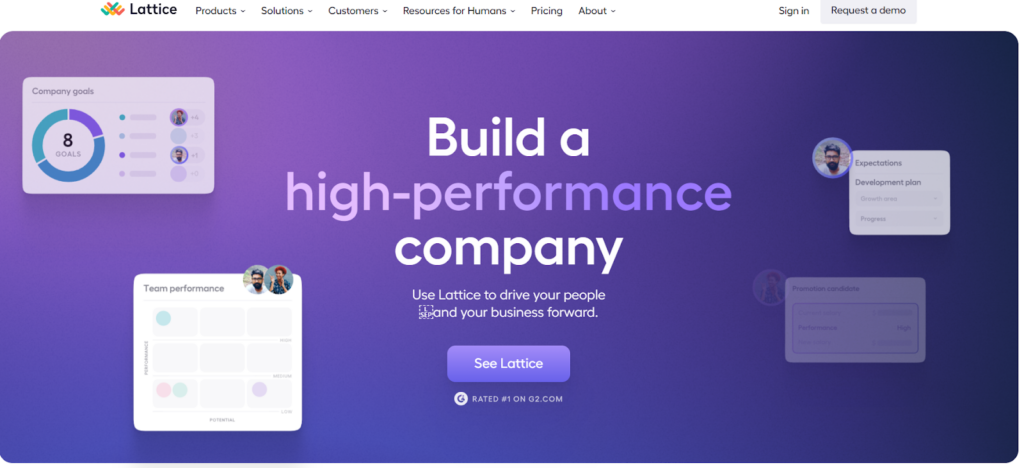
Lattice is a performance management solution that helps organizations boost productivity through its performance management tools, analytics, and other essential features. Its comprehensive set of tools covers performance management, goal setting, compensation management, employee engagement, career development, and analytics. With Lattice, users can efficiently manage their performance management cycles, create customized goals for employees, and improve performance and employee satisfaction.
Notable features of Lattice
1. Performance management tool
It has a comprehensive performance management feature which comprises performance reviews, and 1:1s enables continuous feedback and reports to keep the managers updated.
2. Career development tools
Lattice offers various career development tools, such as career paths and skill tracking, that enable employees to plan and manage their career progression. This feature helps employees identify areas where they need to improve and develop new skills, and provides managers with valuable insights into employee strengths and weaknesses, which can inform training and development plans.
3. Analytics
Lattice provides powerful analytics for data-driven HR decisions that enable tracking performance, and identifying trends and patterns. Lattice’s analytics feature also has AI-powered sentiment analysis to learn how employees feel.
Pros of Lattice
- Lattice promotes employee engagement and provides detailed reports. The system includes robust evaluation tools that enable managers to monitor employee performance and provide guidance on how employees can best achieve their goals.
- Lattice is an ideal tool for companies looking to implement a comprehensive performance management strategy. With its fully built-out features, Lattice can guide organizations towards developing a strategy based on industry best practices for compensation, employee engagement and performance.
- The user interface of Lattice is easy to use and navigate, making it simple to access all the available tools. Lattice’s visualizations and reports are particularly valuable as they present data and insights clearly and concisely.
Cons of Lattice
- The mobile app experience of Lattice is not as seamless and user-friendly as it could be. Some essential features are either missing or not optimized for mobile use, which could make it challenging to access critical information
- Currently, there is no option to mark goals as completed in Lattice. The system continues to remind users about these goals indefinitely unless they are deleted.
4. Workboard
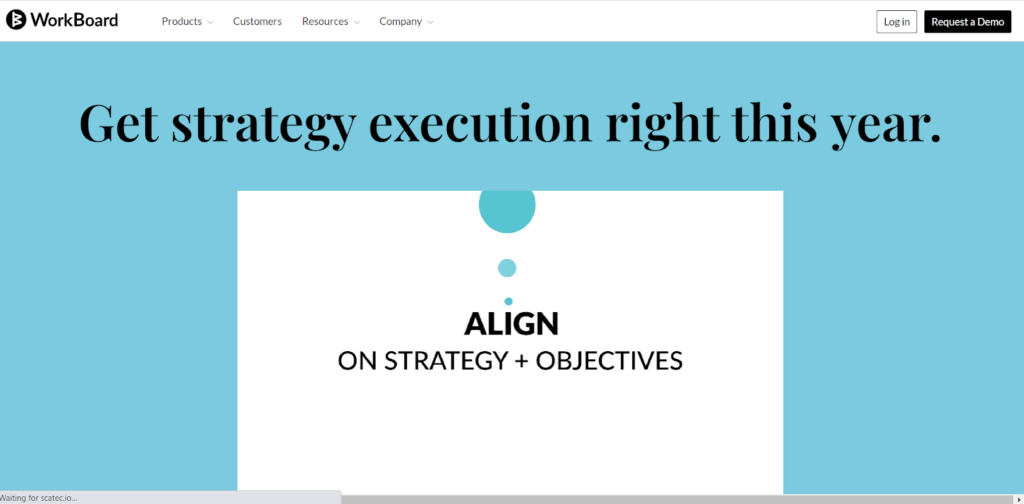
Workboard is another efficient OKR management tool. This cloud-based platform focuses on improving the day-to-day activities that help to speed up goal achievement. With a range of features, including progress tracking and team collaboration tools, Workboard enables organizations to stay aligned, focused, and accountable, while also improving overall productivity and performance.
Notable features of Workboard
1. Canvas for OKR
With Workboard, setting objectives for the first time is made easy through its OKR Canvas feature. This performance management tool provides tips and suggestions to help businesses set the right OKRs, allowing for collaboration with the team to brainstorm ideas and set measurable goals. Workboard’s OKR Canvas feature ensures that objectives are well-planned, achievable, and aligned with the organization’s overall strategy.
2. Alignment across organization
In Workboard, users can easily align and link OKRs in any direction, whether vertically or laterally across functional teams or individuals. With a simple “My OKRs” page, users can stay focused on what matters and quickly find OKRs for a product, team, or person. Additionally, users can map, mirror, roll up or copy key results across multiple OKRs.
3. Wobo Strategy
Workboard’s strategy feature allows you to make plans that cover several years for the business, products, and important initiatives. It allows sharing it with everyone, keeping track of how things are going and making sure the plan makes sense, covering all the important areas, and taking into account any risks or investments that might be needed.
Pros of Workboard
- Workboard’s data visualization features help to communicate complex information and insights clearly, making it easier for teams to understand.
- Workboard allows for the integration of its platform with other tools like Salesforce, Slack, and Jira, which enables users to streamline their workflow and reduce the need to switch between multiple tools.
- Workboard enables easy measurement of progress, enabling transparent progress tracking and automatic calculation of progress towards target outcomes. It also allows updating Key results via Web, mobile or chat, and teams can add confidence ratings and qualitative assessments.
Cons of Workboard
- Although WorkBoard’s platform is powerful, it may sacrifice user-friendliness at times. However, it aims to bridge this gap by providing an extensive resource center and excellent training programs to empower its users.
- The tool is feature heavy which causes slow performance and downtime which hampers seamless user experience and work
5. Profit.Co
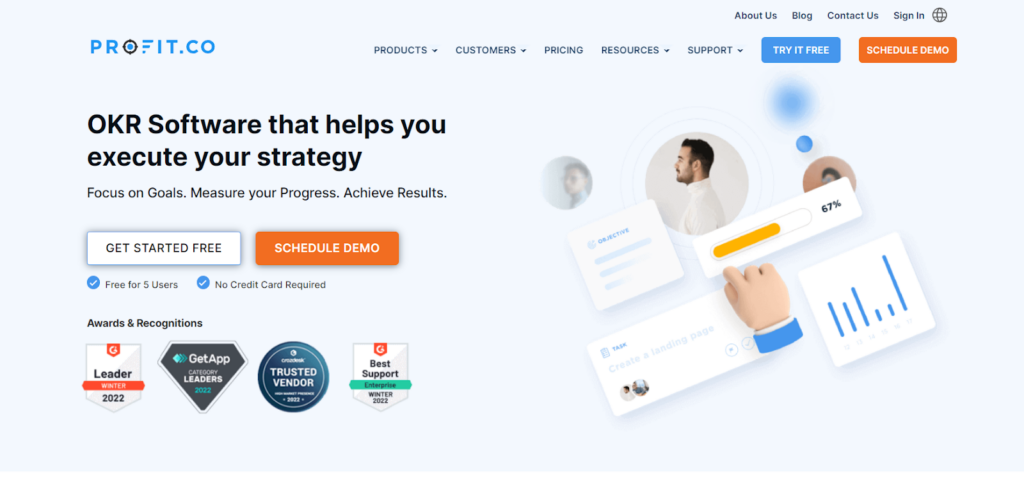
Profit.co is another great tool with an OKR-centric approach to help businesses create a quarterly cycle of planning and execution while providing real-time tracking of task progress. In addition to its performance management features, Profit.co also includes several collaboration tools to boost employee engagement. With Profit.co, businesses can easily align their goals with their overall strategy, improve transparency, and make informed decisions.
Notable features of Profit.co
1. OKR Management
Profit.co’s OKR management software simplifies strategy execution and helps bridge the gap between planning and implementation. Its goal-setting framework offers agile alignment, faster adaptation and execution, and guided weekly check-ins to help businesses achieve their goals efficiently and effectively.
2. Task Management
This intuitive feature helps optimize productivity. It helps in connecting day-to-day work to higher-order company goals and helps align tasks with OKRs, manage workflows, and streamline project execution.
3. Performance management
This is a customizable feature and helps in tracking and monitoring employee performance. It also has a highly customizable review process, creating a high-performing work culture by identifying talent and nurturing employee capabilities.
Pros of Profit.co
- Profit.co’s performance management system features a highly customizable review process, enabling businesses to tailor their performance evaluations to their specific needs.
- It has a comprehensive OKR management system, which helps align goals with the overall strategy, track progress in real time, and make data-driven decisions.
- Profit.co integrates with several other popular software applications, including Slack, Jira, and Google Sheets, making it easier for businesses to streamline their workflows and share data across platforms
Cons of Profit.co
- While Profit.co’s interface is user-friendly, some users may still find the software challenging to navigate and set up, particularly if they’re not familiar with OKR management frameworks.
- According to users, the abundance of available tools sometimes becomes overwhelming, making it harder to concentrate and stay focused.
6. Perdoo

Perdoo is a comprehensive performance management tool that emphasizes employee engagement and goal achievement. Its real-time tracking and identification of shortcomings enable businesses to quickly adjust and optimize their strategies. It also offers industry-level resources for maximum efficiency and output, making it a powerful tool for businesses of all sizes.
Notable features of Perdoo
1. Strategy timelines and roadmaps
It allows you to eliminate static documents and simplify your strategy with a drag-and-drop interface. Analyze what worked in the past, make adjustments, and design your future with ease.
2. KPI Boards
The KPI board helps in planning, tracking, and delivering your KPIs easily. It ensures that the goals everyone is working on align with the business growth strategy.
3. Clear Communication
Perdoo effectively communicates strategy with clarity. It adds logic and reasons to the strategic decisions on how you differentiate yourself from competitors and allows you to easily share those decisions with team members.
Pros of Perdoo
- Intuitive and easy-to-use design, even for those who are not familiar with performance management software.
- The platform is highly customizable, allowing organizations to tailor it to their specific needs.
- The OKR Map provides a visual representation that breaks down the company’s vision into strategic pillars and OKRs, making it easy to visualize and understand.
Cons of Perdoo
- Sometimes it’s challenging to get an overview of the strategy or roadmap when there are too many details, and users may need to zoom out to see the entire map.
- While Perdoo provides useful hints and information to help users understand OKRs better, new users may need some time to adjust to the interface.
- A comprehensive overview of the entire company can be challenging to obtain as there are several reports and custom report options available
7. UnlockOKR
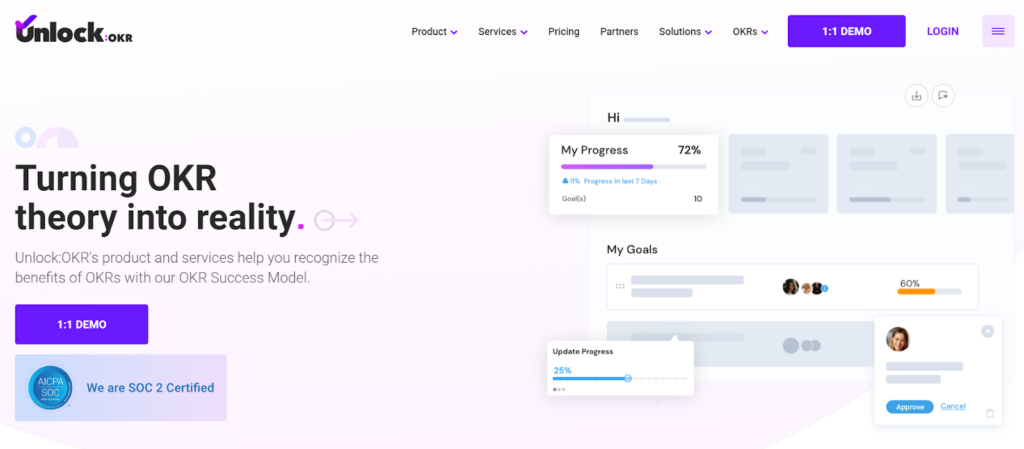
UnclockOKR is an OKR-focused tool and helps organizations recognize the benefits of OKR and implement it. It works towards building an outcome-first culture and tries to simplify the implementation of the OKR strategy.
Notable features of UnlockOKR
1. People map and goal map
This feature creates visibility of what is doing what and helps identify stakeholders working on the same goals
2. Alignment and reporting
It simplifies the alignment of goals with the top-down assignment of OKRs. It also has an intuitive dashboard which drives focus on what matters and open communication between cross-functional teams.
3. Unlock Marketplace
This has several features and tools offering to learn towards seamless OKR implementation. The tools can be modified based on the need and used to leverage the power of OKR.
Pros of UnlockOKR
- Unlock OKR has an intuitive interface which is designed for ease of use and mass appeal. It claims that users can start using it in 1 day without taking extensive training.
- It offers integration with tools used for creating a seamless work experience and simplifying work like Jira, Slack, etc.
- It provides instant insights to everyone on board through the role-based dashboard, which can also be customized.
Cons of UnlockOKR
- Users can feel the need to control their notifications a little bit. Although, it is under admin to set notifications for the team for their upcoming or delayed tasks, still there are times when the team lacks control over configuring notifications as well.
- The tool can be more intuitive. When compared to others in the market, there are times when the tool lacks task intuitivity and that can hamper the user experience.
8. SugarOKR
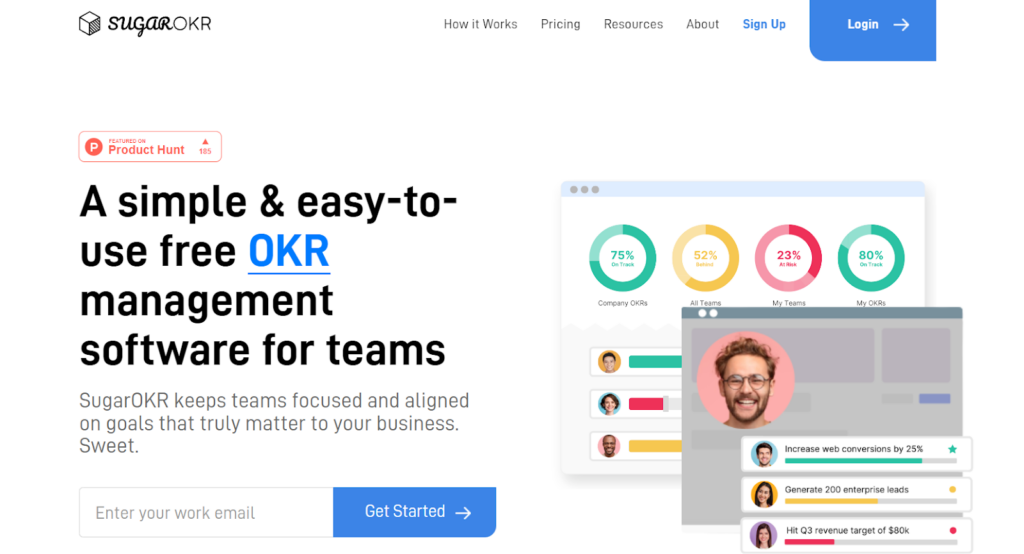
This tool is again an OKR-focused tool. It highly emphasizes building trust and accountability, aligning company-wide goals, and improving performance. It lets you create OKRs easily and assign them to teams and individuals, customize key results and easily update on the progress using the sidebars.
Notable features of SugarOKR
1. Creating OKRS
SugarOKR follows the simple rules of OKR in its software and lets you create OKRs, assign them, customize the key results and update their progress. It automatically updates the objectives as KRs are updated.
2. Strong Alignment
It focuses on building a strong alignment of objectives, and OKRs from the company to an individual level. It gives you a bird’s eye view for each quarter to keep track of OKR
Pros of SugarOKR
- Easy creation of OKRs and assignment of tasks to teams
- It provides your charts on the past performance of employees
- It lets you monitor performance and progress on a single dashboard
Cons of SugarOKR
- It doesn’t offer employee engagement surveys that can help you gauge if employees are happy with their work or not.
- It fails to offer integration options with basic tools that can help you implement your OKRs efficiently.
9. Asana
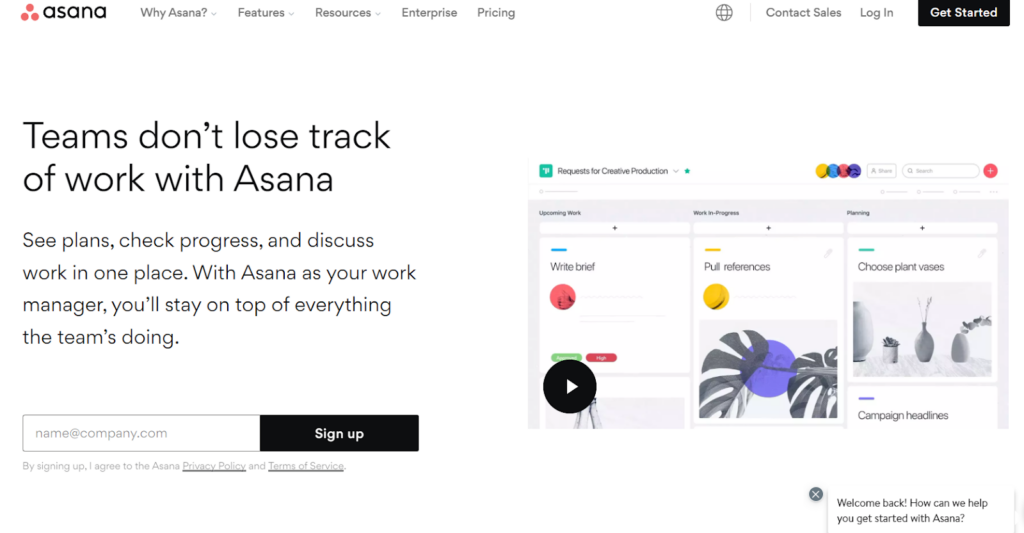
Asana is a popular project and task management tool that is widely used by teams of all sizes and industries. It provides a comprehensive set of features that enable teams to manage their workflows efficiently, collaborate seamlessly, and achieve their goals. It offers tools for task organization, automating recurring tasks, and staying in control. It is a comprehensive tool which assists you with project planning and tracking progress in a single shared space.
Notable features of Asana
1. Project planning
It has a robust project planning feature which allows you to stay on the timeline, manage work requests and start projects faster. You can create project timelines, set milestones and dependencies, and track progress with visual timelines and Gantt charts.
2. Real-time progress reports
It offers real-time project dashboards and data in a single place. This feature allows you to monitor progress across all tasks and projects, and track how much work has been completed and how much is left to do. You can create custom project dashboards that display KPIs such as project completion rate, team productivity, and task progress.
3. Controlled visibility
It allows controlled visibility through its private and comment-only project features to protect sensitive work and ensure that no one can change the data.
Pros of Asana
- It is excellent for streamlining daily activities and tasks; and large-scale projects.
- The customization offered by Asana and mobile app integration boosts productivity and make it a very helpful project management tool
- It is very easy to navigate and understand because of its intuitive UI which lets even a non-tech person easily use the platform for single-use features.
Cons of Asana
- Since it is a comprehensive tool offering several solutions, it becomes confusing for someone to use the entire tool initially.
- It is expensive compared to other OKR tools
10. ClickUp
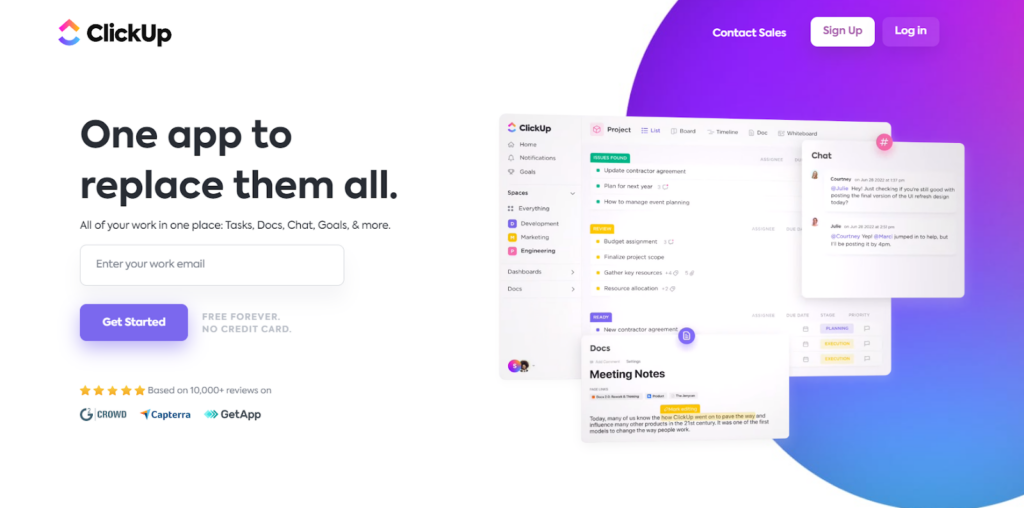
ClickUp is a powerful project management tool that allows teams to manage their tasks, projects, and workflows in one place. With its intuitive interface and a wide range of features, ClickUp makes it easy for teams of all sizes to collaborate effectively and streamline their workflows.
Notable features of ClickUp
1. Task management
ClickUp’s task management feature is incredibly robust and customizable. You can create tasks, set due dates, assign them to team members, and add descriptions, comments, and attachments. You can also use custom fields and tags to organize your tasks based on priority, status, or any other criteria you choose.
2. Collaboration
ClickUp makes it easy for teams to work together and stay in sync. You can create shared spaces for teams or projects, and invite team members to collaborate. You can also use ClickUp’s real-time editing and commenting features to communicate with your team members and get feedback on your work.
3. Customization
ClickUp is highly customizable and adaptable to unique needs. You can customize task views, create custom fields and tags, set up automation, and use integrations to connect ClickUp with other tools your team uses.
Pros of ClickUp
- ClickUp offers a comprehensive set of features that cover task management, time tracking, project management, collaboration, and more. This makes it an all-in-one solution for teams looking to streamline their workflows.
- Its user-friendly interface makes it easy for teams to get started quickly and navigate the tool effortlessly. The tool offers a variety of views such as list, board, calendar, and timeline, which cater to different team preferences.
- ClickUp integrates with a variety of other tools such as Google Drive, Slack, Trello, Asana, and many others, which enables teams to work seamlessly across different platforms.
Cons of ClickUp
- Sometimes the page is not automatically refreshed. So, when you modify a task’s status while browsing a page with multiple tasks, and save the change, the page might not refresh to reflect the update.
- While the tool is very useful, the Android app does not currently meet the required expectations.
How to Conduct OKR Software Comparison
With so many tools available in the market, choosing one becomes challenging. Conducting an OKR tool comparison will help you evaluate the tools based on the solutions they offer and which one best suits your needs. When comparing different OKR software, some criteria to consider are:
- Ease of Use: How easy is it to use the platform? Is it a people’s favorite or awarded #1 for ease of use?
- User Interface: Is the software user-friendly and intuitive? Does it offer a variety of views, such as lists, boards, and charts, to cater to different user preferences?
- Goal Management: How well does the software manage goals, objectives, and key results? Does it offer a clear and structured way to define and track OKRs? Does it understand the challenges faced by leaders and puts OKR at the center and forefront?
- Customization: How customizable is the software? Can users create custom fields, tags, and templates to fit their unique needs and workflows?
- Collaboration: How well does the software facilitate collaboration among team members? Does it offer features such as comments, @mentions, and real-time updates to keep everyone on the same page?
- Integration: How well does the software integrate with other tools, such as project management software, CRM software, and analytics software? Does it offer a wide range of integration options like integration with more than 100+ native tools?
- Reporting and Analytics: How well does the software track and analyze progress towards goals? Does it offer data visualizations and reports that help users make informed decisions?
- Cost: How much does the software cost? Is it affordable for small teams and businesses with tight budgets? Does it offer transparent pricing and no hidden fees?
By considering these criteria, teams can choose the OKR software that best fits their needs and helps them achieve their objectives.
Top 5 Features to Check Before Buying OKR Tool for Your Business
Before you settle on a tool, do check for these features in the different OKR tools and evaluate them on these features.
1. Simple interface
An OKR software should offer a simple and intuitive user experience, featuring a clean and attractive interface that is easy to navigate without being cluttered. The best OKR tools prioritize ease of use, allowing employees to utilize the tool with minimal guidance.
2. Allows reviews and feedback
Managing multiple objectives and key results across various teams can be challenging. However, OKR software can alleviate this problem through its Review and Feedback feature. The best OKR software facilitates peer review and promotes a culture of feedback, allowing teams to collaborate and provide feedback on each other’s work. This fosters an environment of continuous improvement, helping teams move together towards achieving their objectives.
3. Alignment and cascading OKRs
One crucial feature that every top-rated OKR software should offer is the ability to Align and Cascade OKRs. As teams work together towards achieving overarching company-level OKRs, the best OKR tools enable them to cascade their shared OKRs from one level to another. This means that the key results of the management team, for instance, can be easily shared and integrated into the individual OKRs of a team member.
4. Analytics and reports
Top-performing OKR tools boast a comprehensive reporting system that enables you to monitor your team’s progress at every stage. It detects bottlenecks before they impede business growth. With the right analytics, you can make data-driven decisions and enhance your team’s performance.
5. Check-ins and follow ups
Top-rated OKR software solutions provide a follow-up and check-in feature that allows you to assess your team’s progress. The check-ins are critical for enabling teams to overcome obstacles that hinder the success of their OKRs and develop the right mindset to achieve them.
How to Choose the Best OKR Tool for Your Business?
Choosing the right OKR tool is essential for any organization looking to effectively set and track their goals. With so many options available, it can be overwhelming to determine which tool is the best fit. By evaluating these aspects and understanding your organization’s specific needs, you can choose the OKR tool that will help your team stay focused, aligned, and accountable towards achieving their objectives.
1. Identify your organization’s needs: Before selecting an OKR tool, identify the needs of your organization, such as the number of users, OKR complexity, and integration requirements.
2. Consider user-friendliness: Choose an OKR tool that is user-friendly and easy to navigate for your team members, as it will help them to adopt the tool and use it effectively.
3. Scalability: Select an OKR tool that can scale with your organization’s growth and accommodate an increasing number of users and objectives.
4. Desirable Features: When searching for user-friendly OKR software, it’s important to also consider the necessary features to ensure the effective implementation of OKRs. Consider these feature checklists:
A. Transparency functionality
B. Ability to share and comment on OKRs
C. Notifications for OKRs to users
D. Collaborative capabilities with other team members
E. Integration with other tools such as MS Teams or Slack
F. Dashboard for a comprehensive view
By keeping these features in mind, you can make a well-informed decision on selecting the right OKR tool that best fits your needs. Check this blog for detailed tips on how to choose your OKR tool.
What Are You Waiting For?
Build and reinforce great OKR practices by introducing OKR software. And help your teams to prioritize and align in the best way possible.
Conclusion
There are many great OKR tools available that can help you set, track, and achieve your goals effectively. Each of the ten tools we reviewed has its unique features and benefits, making it important to consider your specific needs and requirements when selecting the best tool for you or your team.
Whether you’re looking for a user-friendly interface, robust features, or integration capabilities, there is an OKR tool that can meet your needs. By taking the time to research and choose the right OKR tool, you can increase your chances of success and achieve your goals more efficiently.





